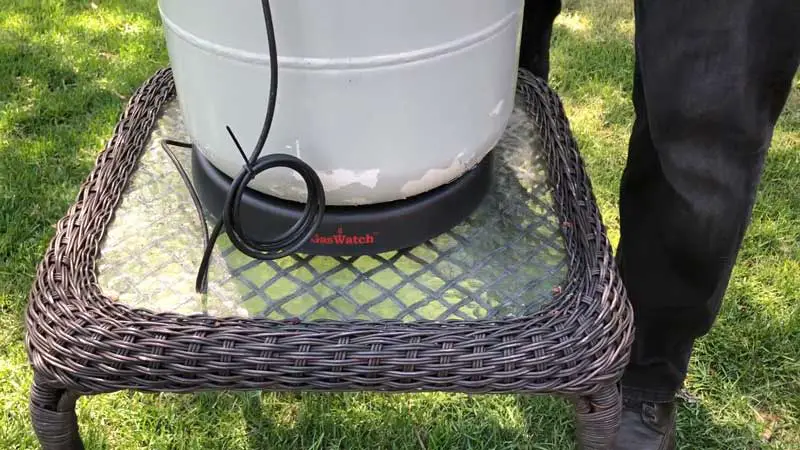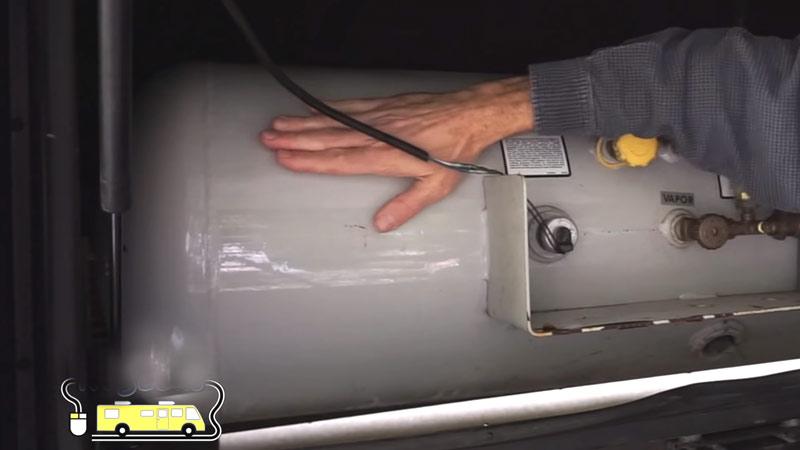How Can You Tell If A Propane Tank Is Empty Without A Gauge

Not all propane tanks come with a gauge. However, you need to know if the propane tank is empty. There are a few ways to determine this.
You can weigh the tank to see if it is empty. You can also use water to estimate the level. Using these methods helps estimate the gas remaining.
In this article, we’re going to discuss the methods so that you can determine if a propane tank is empty or not. Let’s get started.
You'll Learn About
The Gauge on a Propane Tank
If you have a propane tank, you will need to know where the gauge is located. This is a device that tells you how much fuel is left in the tank. Details are described below:
What does the Gauge do?
The gauge on a propane tank will show the amount of propane remaining in the tank, as well as how full it is. It will also indicate the approximate percentage of fuel in the tank.
Tanks are typically filled to about 80% capacity to allow for expansion. If you’re trying to figure out if your tank is at its maximum capacity, you can check the Water Capacity (WC) or Tare Weight (TW) stamped on the collar.
These markings represent standardized measurements.
Numbers on Gauges
Gauges usually indicate the percentage of fuel remaining. For example, a gauge reading 50% on a 20-gallon tank indicates about 10 gallons remain.
Read Labels Carefully
Do not overfill propane tanks; they should only be filled to the specified safe level (usually 80%) to prevent dangerous pressure buildup.
Always read labels carefully when purchasing any type of product – especially when it comes to gases like propane.
How to Tell a propane Tank is Empty
Propane tanks are designed to hold a certain amount of propane in them. If your tank is empty or near empty, you’ll be able to use the propane that’s left in it, but it won’t be enough to run any appliance that needs propane, including your stove, oven, refrigerator, or water heater. A propane tank needs to be refilled when it is empty.
There are many methods of telling a propane tank is empty. Let’s discuss them:
Measure the Weight of the Propane Tank
To determine how full your propane tank is, you can weigh it on a scale and subtract the tare weight from its actual weight. The tare weight represents the empty condition of the tank and will be different depending on the tank size.

Check the tare weight to calculate the remaining fuel. If at any time you notice an increase or decrease in your propane tank’s overall mass, consult with a professional immediately as this could indicate potential problems with either the appliance being fueled by propane or with your home’s safety system related to Propane usage.
Always keep an eye on odors coming from your appliance; if they become overpowering, have them serviced right away. Be sure to ensure hoses are in good condition and consult a professional for repairs – even if they seem like they’re doing their job properly -as these components can also add up to extra pounds over time and may eventually cause leakage.
Use Water to Estimate the Propane Level
To estimate the propane level in your tank, pour warm water down the side of the tank and run your hand down the outside of it. The liquid propane will absorb the heat, creating a cool spot at the fill level.

If the cool spot is near the bottom, then it’s safe to assume that your propane level is low and you need to refill it. When refilling your propane tanks, always use warm water to create a temperature difference on the tank surface.
Check The Propane Tank Gauge
You can check the propane tank level by looking at the gauge on the front of the tank. The indicator will usually point to either red or green, depending on how much propane is left in the tank. If you see that there is not enough propane remaining in your tank, it’s important to fill it up as soon as possible before it runs out completely and causes an emergency situation.

Refilling a 20-pound tank typically takes only a few minutes while a 100-pounder may require four hours or more due to its size and weight differences. Always be sure to read your owner’s manual for specific instructions on refilling your particular type of gas container.
Never use an open flame or lighter near propane tanks. Make sure all connections are tight after refueling – this includes making sure both valves are fully closed Always store tanks upright to ensure the relief valve functions correctly.
How to Find the Propane Tank Valve?
The valves on your propane tank are pretty simple and straightforward, but there are a few things to bear in mind when using them.
- First, and the most important thing to know is that the valves are on the tank and not the propane line itself. The valves are designed to prevent the propane from flowing through the valve into the tank, and they are usually located on the top of the tank next to the cap.
- The valve you need to turn is the one that is on the top of the tank, and it is not the one on the end of the propane line. You can also ensure the valve is closed before disconnecting lines.
- Finally, if you have been using your propane tank for a while, you may notice that it pressure may drop when the tank is nearly empty or in very cold weather. This is because the propane is flowing out of the tank at a lower pressure than is normal.
The regulator controls pressure; if pressure is inconsistent, consult a professional.
How can you tell if a 100 lb propane tank is empty?
If you’re ever in a situation where you need to know if a 100 lb propane tank is empty, the best way to do so is by using an accurate weight. You can use something like a bathroom scale or hanging scale.
Just be sure not to exceed the weight limit for your tank.
Connect a New Line to Tank Before Checking Again
Before determining if a 100 lb propane tank is empty, make sure that all lines are disconnected and replaced with new ones before checking again. The amount of propane left in a 100 lb tank will vary depending on how much was used.
Place Your Tank on the Scale
To determine if a 100 lb propane tank is empty, you will need to weigh it and subtract the tare weight from the number on the scale. If the weight is near the tank’s stamped tare weight, it is empty.
Subtract Tare Weight from Number on Weight Scale
The amount of propane left in a 100lb tank will vary depending on how much was used. So be sure to account for any unused gas before checking again to see if your tank is still full.
For example, if the tare weight is 20 lbs and the scale reads 70 lbs, the fuel remaining is 50 lbs.
A full 20lbs tank holds about 4.7 gallons of propane. So, the 50lbs propane will be about 11.8 gallons.
How do you tell if you’re out of propane in your house?
If you’re unsure whether or not your propane tank is full, check to see if the propane heater is on. If it’s off, confirm that the tank has been burnt off and check the gauge on your main tank.
If there are none nearby, check other gas appliances; if none work, call your supplier. Never use a match to test for gas.
Check the Level of Propane in Home
To check the level of propane in your home, you first need to identify where the propane tank is located. Once you’ve located the tank, pour a cup of hot water down one side and then run your hand along the side until you find a cool spot.
Next, look at how much water was poured into the tank- this will give you an idea of how much propane is left in it. If there’s not enough propane remaining to allow for proper safety precautions (such as turning off all appliances), then it may be time to refill the tank or replace it altogether.
Propane Tanks without Gauges
Some propane tanks don’t have gauges to show how much fuel is left. This is because these tanks use a different mechanism or have no integrated indicator.
If there’s an emergency, you should rely on weight or external indicators.
Gauges Are Ineffective
Gauges are ineffective because they Pressure gauges do not accurately reflect volume because pressure depends on temperature.
The gauge reads the tank’s pressure relative to atmospheric pressure, which isn’t always accurate. This issue may lead to confusion and incorrect decisions when using your propane tanks.
Tank Pressure Is Relative, Not Direct
The amount of gas that is inside a propane tank is not directly proportional to its pressure reading on the gauge. Pressure readings vary with temperature, not just volume.
There’s No Good Way To Measure Tank Pressure
There isn’t a good way to measure propane tank pressure without special equipment or knowledge about how refineries work. Without knowing exactly how much gas is inside each container, gauging fuel levels becomes difficult and inaccurate over time.
Gauges May Be Falsely Accurate
Gauges may be falsely accurate because they’re based on atmospheric pressure readings rather than true pressures within individual tanks or pipelines. Atmospheric pressure fluctuates constantly throughout day and night so any given reading could be wildly different from another at any given moment – making it unreliable for gauging fuel levels accurately over time.
To Recap
You can easily tell if a tank is empty or not by weighing the tank or using water. But for safety, whenever working with propane tank, bear in mind that you should be careful.
Frequently Asked Questions
How Do You Seal Black Gas Pipes?
You can use yellow gas-rated Teflon tape or Pipe Joint to seal black gas pipes efficiently. The Pipe Joint is the most widely used sealant for black gas pipe. The Pipe Joint is a semi-permanent, high-strength, tape-like sealant.
How Long Does Teflon Tape Last?
Teflon tape can last for many years, depending on the application and environment.
Do I Need to Use a Teflon Tape When Installing Black Gas Pipes?
Yes, you do. Yellow gas-rated Teflon tape is a superior sealing agent. It’s used to seal a variety of pipe types.
